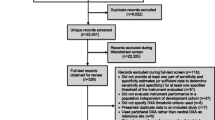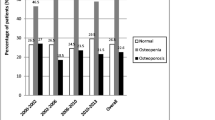Abstract
Clinical decision rules (CDRs) are designed to help physicians practice better. A number of CDRs to assist in identifying women with low bone mass have been developed since the mid 1990s, including SCORE, OST (OSTA), OSIRIS, SOFSURF, NOF, ABONE, pBW, ORAI, and weight-only-EPIDOS (which we have termed WO-E). This review discusses these CDRs in terms of development and validation cohorts and their sensitivity and specificity. The sensitivities of the available CDRs exceed 80% and specificities are about 50%. After much analysis, it appears that most experts prefer OST for its simplicity and SCORE for its flexibility, but there is no consensus on what risk factors to use in the CDRs and what regions of interest (spine, total hip, femoral neck, or a combination) to test with dual-energy x-ray absorptiometry (DXA). Because of the lack of consensus, there are barriers to the clinical application of these CDRs. Agreement on a single CDR for worldwide use is required to optimally fulfill the objective of identifying low bone mass.
Similar content being viewed by others
References and Recommended Reading
Ribot C, Tremollieres F, Pouilles JM: Can we detect women with low bone mass using clinical risk factors? Am J Med 1995, 98:525–555.
Cummings SR, Nevitt MC, Browner WS, et al.: Risk factors for hip fracture in white women. N Engl J Med 1995, 332:767–773.
McGinn TG, Guyatt GH, Wyer PC, et al. for the Evidence-Based Medicine Working Group: Users’ guide to the medical literature: XXII: how to use articles about clinical decision rules. JAMA 2000, 284:79–84.
Lydick E, Cook K, Turpin J, et al.: Development and validation of a simple questionnaire to facilitate identification of women likely to have low bone density. Am J Manag Care 1998, 4:37–48.
Weinstein L, Ullery B: Identification of at-risk women for osteoporosis screening. Am J Obstet Gynecol 2000, 183:547–549.
Michaëlsson K, Bergström R, Mallmin H: Screening for osteopenia and osteoporosis: selection by body composition. Osteoporosis Int 1996, 6:120–126.
Ben Sedrine W, Chevallier T, Zegels B, et al.: Development and assessment of the Osteoporosis Index of Risk (OSIRIS) to facilitate selection of women for bone densitometry. Gynecol Endocr 2002, 16:245–250.
Black DM, Palermo L, Pearson J, et al.: SOFSURF: a simple useful risk factor system can identify the large majority of women with osteoporosis [abstract]. Bone 1998, 23(suppl 1):S605.
Koh LKH, Ben Sedrine W, Torralba TP, et al. on behalf of the Osteoporosis Self-Assessment Tool for Asians (OSTA) Research Group: A simple tool to identify Asian women at increased risk of osteoporosis. Osteoporos Int 2001, 12:699–705.
National Osteoporosis Foundation: Physician’s Guide to Prevention and Treatment of Osteoporosis. Belle Mead, NJ: Excerpta Medica Inc; 1999.
Cadarette SM, Jaglal SB, Kreiger N, et al.: Development and validation of the Osteoporosis Risk Assessment Instrument to facilitate selection of women for bone densitometry. Can Med Assoc J 2000, 162:1289–1294.
Dargent-Molina P, Poitiers F, Breart G, EPIDOS Group: In elderly women weight is the best predictor of a very low bone mineral density: evidence from the EPIDOS study. Osteoporos Int 2000, 11:881–888.
Mucha L, Abbott TA III, Smith B, et al.: Use of pre-screening instrument to detect low bone mass in Asian women. J Bone Miner Res 1997, 12(S1):S593.
Ben Sedrine W, Devogelaer JR, Kaufman JM, et al.: Evaluation of the Simple Calculated Osteoporosis Risk Estimation in a sample of Caucasian women from Belgium. Bone 2001, 29:374–380.
Abbott TAIII, Mucha L, Manfredonia D, et al.: Efficient patient identification strategies for women with osteoporosis. J Clin Densitom 1999, 2:223–230.
Weinstein L, Ullery B, Bourguignon C, et al.: A simple system to determine who needs osteoporosis screening. Obstet Gynecol 1999, 93:757–760.
Reginster J-Y, Ben Sedrine W, Viethel P: Validation of OSIRIS, a prescreening tool for the identification of women with an increased risk of osteoporosis. Gynecol Endocrinol 2004, 18:3–8.
Richy F, Gourlay M, Ross PD, et al.: Validation and comparative evaluation of the Osteoporosis Self-Assessment Tool (OST) in a Caucasian population from Belgium. Q J Med 2004, 97:39–46.
Cadarette SM, Jaglal SB, Murray TM, et al.: Evaluation of decision rules for referring women for bone densitometry by dual-energy x-ray absorptiometry. JAMA 2001, 286:57–63.
Cadarette SM, Jahlal SB, Murray TM, et al.: Who should be screened for osteoporosis? JAMA 2001, 286:1970–1971.
Ben Sedrine W, Reginster J-Y: Risk indices and osteoporosis screening: scope and limits. Mayo Clin Proc 2002, 77:622–623.
Geusens P, Hochberg MC, Van Der Voort DJM, et al.: Performance of risk indices for identifying low bone density in postmenopausal women. Mayo Clin Proc 2002, 77:629–637.
Ben Sedrine W, Broers P, Devogelaer J-P, et al.: Interest of a prescreening questionnaire to reduce the cost of bone densitometry. Osteoporos Int 2002, 13:434–442.
Wallace LS, Rogers E, Keenum AJ, et al.: Promoting osteoporosis screening in postmenopausal women. Women Health Prim Care 2003, 6:380–391.Discusses the use of CDRs in primary care.
Wehren LE, Siris ES: Beyond bone mineral density: can existing clinical risk assessment instruments identify women at increased risk of osteoporosis? J Intern Med 2004, 256:375–380.Evaluates the use of screening tools.
Richy F, Ethgen O, Bruyere O, et al.: Primary prevention of osteoporosis: mass screening scenario or prescreening with questionnaires? An economic perspective. J Bone Miner Res 2004, 19:1955–1960.
Kanis JA, Borgstrom F, De Laet C, et al.: Assessment of fracture risk. Osteoporos Int 2005, 16:581–589.
Cabana MD, Rand CS, Powe NR, et al.: Why don’t physicians follow clinical practice guidelines? A framework for improvement. JAMA 1999, 282:1458–1465.
American Medical Association: Physicians in the United States and possessions by selected characteristics. http://www.ama-assn.org/ama/pub/category/2688.html. Accessed October 4, 2006.
Author information
Authors and Affiliations
Rights and permissions
About this article
Cite this article
Schwartz, E.N., Steinberg, D.M. Prescreening tools to determine who needs DXA. Curr Osteoporos Rep 4, 148–152 (2006). https://doi.org/10.1007/s11914-996-0023-4
Issue Date:
DOI: https://doi.org/10.1007/s11914-996-0023-4




